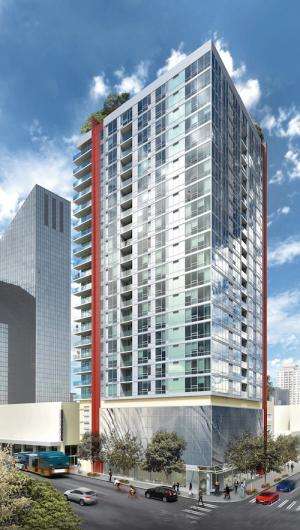Quicker, quake-proof skyscrapers

Peel back the outer layers of a skyscraper built in an area vulnerable to earthquakes and you'll find a tangle of steel-reinforced concrete beams that span doors, windows and other openings in the structure's many supporting walls.
Those coupling beams play a critical role in helping a skyscraper withstand the effects of an earthquake. Yet, says structural engineer Cary Kopczynski, coupling beams reinforced with rebar are congested and difficult to build.
Kopczynski's Bellevue, Washington, structural engineering firm designs high-rise buildings in seismically active areas on the west coast. Nearly a decade ago, he began exploring ways to simplify coupling beam construction.
Along the way, he met C.K. Wang Professor of Civil and Environmental Engineering Gustavo Parra-Montesinos, whose research centers around using fiber-reinforced concrete to improve the behavior of buildings during an earthquake. With University of Michigan colleague James K. Wight and students, Parra-Montesinos developed and tested a fiber-reinforced concrete coupling beam design that virtually eliminates the otherwise standard labyrinth of rebar—yet maintains the building's integrity during an earthquake.
Kopczynski recognized the design's potential and incorporated the design into The Martin, a luxury high-rise apartment building that opened in 2013 in trendy Midtown Seattle. Since the new design wasn't part of the American Concrete Institute building code, Kopczynski worked closely with Steve Pfeiffer, engineering and technical codes manager in the Seattle Department of Planning and Development staff. Kopczynski's presentation to the department included detailed results of Parra-Montesinos' and Wight's research. "What they were claiming was better performance and reduced congestion," says Pfeiffer. "We thought it was good enough to merit a detailed review."
Pfeiffer, who earned his bachelor's degree in civil engineering in 1978 from UW-Madison, engaged two independent peer reviewers. After some minor modifications, he ultimately approved The Martin's coupling beam design.
Although The Martin is its first application, Kopczynski believes the design will see broader use in the future. "It enabled us to remove a significant portion of the reinforcing bar—and the bars that it removed are the most challenging to place, so they're more likely to be constructed properly," he says. "It streamlines construction, reduces cost and speeds up the schedule. And a lot of good things happen."
Provided by University of Wisconsin-Madison




















